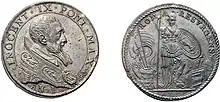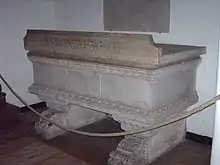Pope Innocent IX
Pope Innocent IX (Latin: Innocentius IX; Italian: Innocenzo IX; 20 July 1519 – 30 December 1591), born Giovanni Antonio Facchinetti,[1] was head of the Catholic Church and ruler of the Papal States from 29 October to 30 December 1591.
Innocent IX | |
|---|---|
| Bishop of Rome | |
 Portrait engraving by Agostino Carracci, 1591 | |
| Church | Catholic Church |
| Papacy began | 29 October 1591 |
| Papacy ended | 30 December 1591 |
| Predecessor | Gregory XIV |
| Successor | Clement VIII |
| Orders | |
| Ordination | 11 March 1544 |
| Consecration | 1560 |
| Created cardinal | 12 December 1583 by Gregory XIII |
| Personal details | |
| Born | Giovanni Antonio Facchinetti 20 July 1519 |
| Died | 30 December 1591 (aged 72) Rome, Papal States |
| Previous post(s) |
|
| Education | University of Bologna |
| Coat of arms | |
| Other popes named Innocent | |
Prior to his short papacy, he had been a canon lawyer, diplomat, and chief administrator during the reign of Pope Gregory XIV (r. 1590–1591).
He entered the service of the influential Cardinal Alessandro Farnese. As papal legate to Venice, he helped negotiate the formation of the Holy League, an alliance of Spanish and Italian maritime powers to challenge the Ottoman Empire’s control of the eastern Mediterranean, and which resulted in victory at the Battle of Lepanto.
Biography
Early life and priesthood
Giovanni Antonio Facchinetti, whose family came from Crodo, in the diocese of Novara, northern Italy, was born in Bologna on 22 July 1519,[2] the son of Antonio Facchinetti and Francesca Cini.
He studied at the University of Bologna - which was pre-eminent in jurisprudence — where he obtained a doctorate in both civil and canon law in 1544. He was later ordained to the priesthood on 11 March 1544 and was appointed a canon of the church of Saints Gervasio and Protasio of Domodossola in 1547.[1]
He traveled to Rome and he became the secretary to Cardinal Nicolò Ardinghelli before entering the service of Cardinal Alessandro Farnese, brother of the Duke of Parma and grandson of Pope Paul III (1534–1549). The cardinal, who was the Archbishop of Avignon, sent Facchinetti there as his ecclesiastical representative and subsequently recalled him to the management of his affairs at Parma.[3] He was also made the Referendary of the Apostolic Signatura in 1559 and held that post for a year.
Episcopate and cardinalate
In 1560, Facchinetti was named as the Bishop of Nicastro, in Calabria, and in 1562 was present at the Council of Trent. He was the first bishop to actually reside in the diocese in three decades. Pope Pius V (1566–1572) sent him as papal nuncio to Venice in 1566[1] to further the papal alliance with Spain and Venice against the Turks, which ultimately resulted in the victory of Lepanto in 1571. He was recalled from Venice in 1572 and was made the Prior Commendatario of S. Andrea di Carmignano in the diocese of Padua from 1576 to 1587.[4]
Relinquishing his see to pursue his career in Rome in 1575 and also because of health reasons, he was named the Titular Latin Patriarch of Jerusalem in 1572.[3] He occupied that post until he was made a cardinal. Pope Gregory XIII made him a cardinal on 12 December 1583 as the Cardinal-Priest of Santi Quattro Coronati and he was to receive the red hat and title on 9 January 1584. Pope Gregory XIV made him the Prefect of the Apostolic Signatura in 1591.
Papacy
| Papal styles of Pope Innocent IX | |
|---|---|
 | |
| Reference style | His Holiness |
| Spoken style | Your Holiness |
| Religious style | Holy Father |
| Posthumous style | None |

Even before Pope Gregory XIV died, Spanish and anti-Spanish factions were electioneering for the next pope. Philip II of Spain's (r. 1556–1598) high-handed interference at the previous conclave was not forgotten: he had barred all but seven cardinals. This time the Spanish party in the College of Cardinals did not go so far, but they still controlled a majority, and after a quick conclave they raised Facchinetti to the papal chair as Pope Innocent IX. It took three ballots to elect him as pope. Facchinetti received 24 votes on 28 October but was not successful. He received 28 votes on 29 October in the second ballot while the third saw him prevail.[5] Facchinetti took his papal name to honor Pope Innocent III.
The cardinal protodeacon Andreas von Austria crowned Innocent IX as pontiff on 3 November 1591. He elevated two cardinals to the cardinalate in the only papal consistory of his papacy on 18 December 1591.
Mindful of the origin of his success, Innocent IX supported, during his two months' pontificate, the cause of Philip II and the Catholic League against Henry IV of France (r. 1589–1610) in the French Wars of Religion (1562–1598), where a papal army was in the field.[6]
His grandnephew Giovanni Antonio Cardinal Facchinetti de Nuce, Jr., was one of two cardinals appointed during the weeks of Innocent IX's pontificate. A later member of the cardinalate was his great-grandnephew Cesare Facchinetti (made a cardinal in 1643).
Death

On 18 December, despite being ill, the pope made a pilgrimage of Rome's seven pilgrimage churches and caught a cold as a result. This became a heavy cough combined with a fever that led to his death shortly after he received Extreme Unction.[5]
Innocent IX died in the early morning of 30 December 1591. He was buried in the Vatican grottoes in a simple tomb.
See also
References
- Martin, John Jeffries. Venice's Hidden Enemies: Italian Heretics in a Renaissance City, (University of California Press, 1993), 183.
- "Innocent IX", The Holy See
- Weber, Nicholas. "Pope Innocent IX." The Catholic Encyclopedia Vol. 8. New York: Robert Appleton Company, 1910
 This article incorporates text from this source, which is in the public domain.
This article incorporates text from this source, which is in the public domain. - Richard P. McBrien, Lives of the Popes, (HarperCollins, 2000), 295.
- Adams, John Paul (24 July 2015). "Sede Vacante 1591". Retrieved 21 January 2019.
- McBrien 2000, p. 296.
![]() This article incorporates text from a publication now in the public domain: Herbermann, Charles, ed. (1913). "Pope Innocent IX". Catholic Encyclopedia. New York: Robert Appleton Company.
This article incorporates text from a publication now in the public domain: Herbermann, Charles, ed. (1913). "Pope Innocent IX". Catholic Encyclopedia. New York: Robert Appleton Company.
External links
- The Cardinals
- Cravegna official website (in Italian)